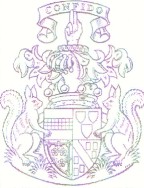|
The Boyd family, is an ancient family, Gaelic, and of Royal Lineage, first appearing during the 11th century in
the Scottish Highlands. The Boyd family derives its descent from Simon, the third son of Alan, Lord High Chancellor of Scotland.
Simon, a brother of Walter, 1st High Steward of Scotland, was descended from Alan of Dol ( Alan of Dol is son of Flathald
Fitzalan), who migrated from the north coast of Franc, in 1066 A.D.. In that year William the Conqueror, Duke of Normandy,
was victorious at the Battle of Hastings, and became King of England.
Simon followed his brother into Scotland and witnesses is foundation charter of the monastery of Paisley, in 1160,
and in this charter Simon is designated, "Frater, Walteri, Filli, Allani."
Simon was the father of Robert Boidh(Boidh is Gaelic term for fair haired), whose son RObert was knighted and
granted the original Boyd coat of arms in recognition of his services in the Battle of Largs at Goldberry Hell, 1263.
A Robert Boyd was first found noted in Scottish records in 1240 AD. The first chief of the Boyds was Sir Robert Boyd who fought
at the Battle of Bannockburn 24 June 1314. For his loyalty & actions, King Robert the Bruce rewarded him with the Barony
of Kilmarnock- which became the family seat.
Construction on Kilmarnock Castle begins at this point. The loyalty
of this family to the cause of Scottish independence earned them the nickname Confido or "Trusty Boyds". In 1466 the
Boyds of Kilmarnock reached the height of their power when Lord Boyd became the guardian for King James III. In 1469 the Boyds
fall from ascendancy.
Eventually the Boyds recovered their lands in the parishes of Darly, Kilbride, and Kilmarnock. Like most
Scottish families, the Boyds feuded with their neighbors such as the Montgomeries and the Stewarts of Darnley.
In the 15th and 16th century, several branches of the family produced prominent scholars such as James Boyd, Archbishop of
Glasgow and Zachary Boyd who translated the bible into verse. It is during this time some of the Boyds move to Ulster in Ireland.
The last chief of this ancient line of Boyds was William, 4th Earl of Kilmarnock. William participated in the Jacobite
rising of 1745 and was beheaded for treason. The chiefdomship of the Boyd family ceased to exist although several branches
lasted into the 19th century.
During this time, several Boyd families were taking prominent role in the development of the American colonies.
The Boyds of Mecklenburg County, Virginia, Boston, Massachusetts, York County, Maine, and Georgia. The Ulster-Scot Boyds entered
the USA through Pennsylvania and then followed the migration trails heading south and westward.
BoydGenealogy@yahoo.com

|
 |
 |
Kilmarnock Castle
A Boyd Ancestral Castle

Dean Castle
formerly known as Kilmarnock Castle
Kilmarnock, Scotland
The primary seat of the Boyds for over
400 years. The castle is located about a mile north of the town Kilmarnock, in the county of Ayr, in western Scotland. It
is now open
to the public as "Dean Castle Country Park," belonging to the Kilmarnock and Louden District Council.
The
name "Dean" is an old Scottish term for a wooded glen.
|
 |
 |
|



